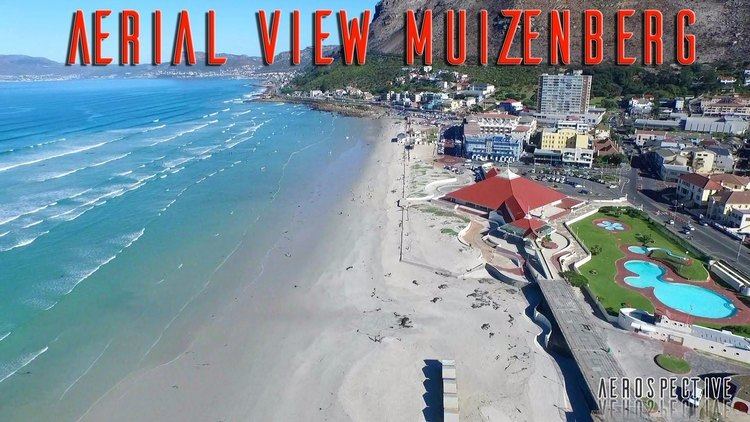Postal code (street) 7945 Local time Tuesday 9:33 AM | Established 1743 PO box 7950 | |
 | ||
Weather 26°C, Wind SE at 10 km/h, 52% Humidity University African Institute for Mathematical Sciences Points of interest Muizenberg Beach, Boyes Drive, Muizenberg Water Slides, Surfers Corner, Rhodes Cottage Museum | ||
Muizenberg cape town south africa an aerial view
Muizenberg is a beach-side suburb of Cape Town, South Africa. It is situated where the shore of the Cape Peninsula curves round to the east on the False Bay coast. It is considered to be the birthplace of surfing in South Africa and is currently home to a surfing community, centered on the popular 'Surfer's Corner'. Agatha Christie, famous author and playwright, wrote that after nursing duty she would daily take the train to Muizenberg to go surfing.
Contents
- Muizenberg cape town south africa an aerial view
- Map of Muizenberg Cape Town 7945 South Africa
- Nearby places of interest
- References
Map of Muizenberg, Cape Town, 7945, South Africa
Historically, the village has several special features, including Het Posthuys (the Post House), Rhodes' Cottage, and the site of the Battle of Muizenberg.
Rhodes' Cottage is a small house on the seafront that Cecil Rhodes bought as a holiday cottage and this was where he died in 1902. The house is preserved as a museum dedicated to Rhodes' life and is open to the public.
Het Posthuys is one of the oldest buildings in South Africa, dating to circa 1742. It was built by the Dutch East India Company (Vereenigde Oost-Indische Compagnie or VOC) as a toll-house to levy a tax on farmers passing by to sell their produce to ships lying in Simon's Bay. One of the early postholders was Sergeant Muys (meaning "mouse"), from whom Muizenberg (formerly Muysenbergh and Muys Zijn Bergh (Muys' mountain) before that) gets its name. After a varied career as a police station, stables, brothel, hotel and private house the building was identified for what it was in the 1980s and restored with funds from Anglo American Corporation. The house is cared for by the Muizenberg Historical Conservation Society and contains a small collection of photos and items of interest relating to early days in Muizenberg. It is open to the public.
The Battle of Muizenberg was a small but significant military affair that began on 7 August 1795 and ended three months later with the (first) British occupation of the Cape. Thus began the period (briefly interrupted from 1804 to 1806) of British control of the Cape, and subsequently much of Southern Africa. The historical remnant of the Battle of Muizenberg is a site on the hillside overlooking False Bay that holds the remains of a defensive fort started by the Dutch in 1795 and expanded by the British from 1796 onwards.
Cannons from that era are mounted at "Het Posthuys", the Muizenberg Park and on the station platform
The Muizenberg Battle site flanks the home of the first Italian Envoy Extraordinary and Minister Plenipotentiary to South Africa, Prince Natale Labia. Originally called "The Fort" after the site of the battle, it now bears the name Casa Labia and is a restaurant, conference centre and music venue. The house was built by skilled Italian artisans and houses part of the Labia family's extensive art collection.
Behind Casa Labia lies the grave site of Abe Bailey, one of South Africa's early and important mine magnates. The graveyard is maintained by the Muizenberg Historical Conservation Society. One of the few houses on the sea side of the railway line, is the thatched cottage owned by Bailey and called Bailey's Cottage. This is owned by the South African Navy.
Many of the buildings in Muizenberg date from the resort town's heyday and are built in the art deco style. At its peak the Muizenberg beachfront attracted masses of holiday-makers and the beach in front of the pavilion earned the name "The Snake Pit". It boasted a large Jewish population that attended the synagogue in Camp Rd. The community is celebrated in a book called "The Stetl by the Sea".
The famous architect, Sir Herbert Baker, designed his house "Sand Hills" on Atlantic Road, was the architect for "Vergenoegd" further along the same road, and designed "Coel an Mar" on Main Rd.
Muizenberg has a fine, long beach that in effect stretches all the way round the top of False Bay to the Strand, a distance of over 20 km. False Bay, known for its population of White Sharks, also has a shark watch service that operates from Muizenberg, signalling alerts when sharks come in proximity of bathers and surfers. Above Muizenberg there is a line of steep cliffs that is very popular as a venue for rock climbing. However, certain parts of the cliff are off-limits to climbers when birds nest on the ledges.
The Zandvlei estuary enters the ocean in Muizenberg. The estuary is one of the most important estuaries for fish spawning on the coastline and is home to the Imperial Yacht Club and Peninsula Canoe Club.
Muizenberg houses one of the False Bay College campuses in the Cinnabar Building, a high-rise apartment tower. The college, a Public Further Education and Training Institution (FET), was established in September 2002 when the South Peninsula College (established 1970) and the Westlake College (established 1954) were merged. Muizenberg is also home to the African Institute for Mathematical Sciences (AIMS), a pan-African centre for education and research in mathematical sciences.
